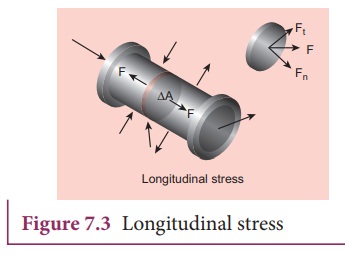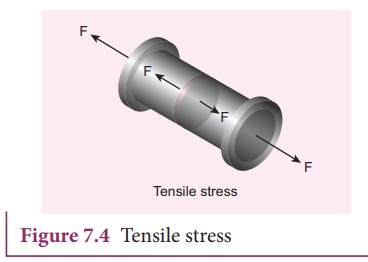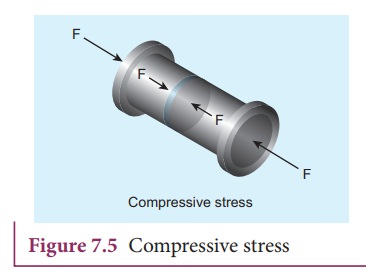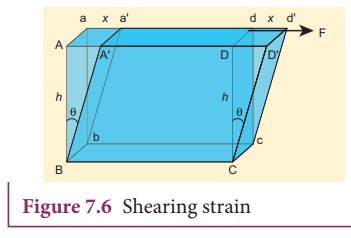Properties of Matter - Stress and strain | 11th Physics : UNIT 7 : Properties of Matter
Chapter: 11th Physics : UNIT 7 : Properties of Matter
Stress and strain
Stress
and strain
(a) Stress:
When
a force is applied, the size or shape or both may change due to the change in
relative positions of atoms or molecules. This deformation may not be
noticeable to our naked eyes but it exists in the material itself. When a body
is subjected to such a deforming force, internal force is developed in it,
called as restoring force. The force per unit area is called as stress.

The
SI unit of stress is NŌĆåm-2 or pascal (Pa) and its dimension is [ML-1T-2].
Stress is a tensor.
(i) Longitudinal stress and shearing stress:

Let
us consider a body as shown in Figure 7.3. When many forces act on the system
(body), the center of mass (defined in unit 5) remains at rest. However, the
body gets deformed due to these forces and so the internal forces appear. Let
ŌłåA be the cross sectional area of the body. The parts of the body on the two
sides of ŌłåA exert internal forces ![]() and
ŌłÆ
and
ŌłÆ![]() on each
other which is due to deformation. The force can be resolved in two components,
Fn normal to the surface
ŌłåA (perpendicular to the surface) and Ft
tangential to the surface ŌłåA (tangent to the surface). The normal stress or
longitudinal stress (Žān)
over the area is defined as
on each
other which is due to deformation. The force can be resolved in two components,
Fn normal to the surface
ŌłåA (perpendicular to the surface) and Ft
tangential to the surface ŌłåA (tangent to the surface). The normal stress or
longitudinal stress (Žān)
over the area is defined as

Similarly,
the tangential stress or shearing stress Žāt
over the area is defined as

Longitudinal
stress can be classified into two types, tensile stress and compressive stress.
Tensile stress

Internal
forces on the two sides of ŌłåA may pull each other, i.e., it is
stretched by equal and opposite forces. Then, the longitudinal stress is called
tensile stress.
Compressive stress

When forces acting on the two sides of ŌłåA push each other, ŌłåA is pushed by equal and opposite forces at the two ends. In this case, ŌłåA is said to be under compression. Then, the longitudinal stress is called compressive stress.
(ii) Volume stress
This
happens when a body is acted by forces everywhere on the surface such that the
force at any point is normal to the surface and the magnitude of the force on a
small surface area is proportional to the area. For instance, when a solid is
immersed in a fluid, the pressure at the location of the solid is P, the force
on any area ŌłåA is
F = P ŌłåA
Where,
F is perpendicular to the area. Thus,
force per unit area is called volume stress.

which
is the same as the pressure.
(b) Strain:
Strain
measures how much an object is stretched or deformed when a force is applied.
Strain deals with the fractional change in the size of the object, in other
words, strain measures the degree of deformation. As an example, in one
dimension, consider a rod of length l
when it stretches to a new length Ōłål then

╬Ą is a dimensionless quantity and has no unit.
Strain is classified into three types.
(1) Longitudinal strain
When
a rod of length l is pulled by equal
and opposite forces, the longitudinal strain is defined as

Longitudinal
strain can be classified into two types
(i) Tensile strain: If the length is increased from its natural length then it is
known as tensile strain.
(ii) Compressive strain: If the length is decreased from its natural length then it is known as compressive
strain.
![]()
![]()
(2) Shearing strain

Consider
a cuboid as shown in Figure 7.6. Let us assume that the body remains in
translational and rotational equilibrium. Let us apply the tangential force F
along AD such that the cuboid deforms as shown in Figure 7.6. Hence, shearing
strain or shear is (╬Ąs)

For
small angle, tan╬Ė Ōēł ╬Ė
Therefore,
shearing strain or shear,

(3) Volume strain
If
the body is subjected to a volume stress, the volume will change. Let V be the original volume of the body
before stress and V + ŌłåV be the change in volume due to stress. The volume strain
which measures the fractional change in volume is

Elastic Limit
The
maximum stress within which the body regains its original size and shape after
the removal of deforming force is called the elastic limit.
If
the deforming force exceeds the elastic limit, the body acquires a permanent
deformation. For example, rubber band loses its elasticity if pulled apart too
much. It changes its size and becomes misfit to be used again.
Related Topics